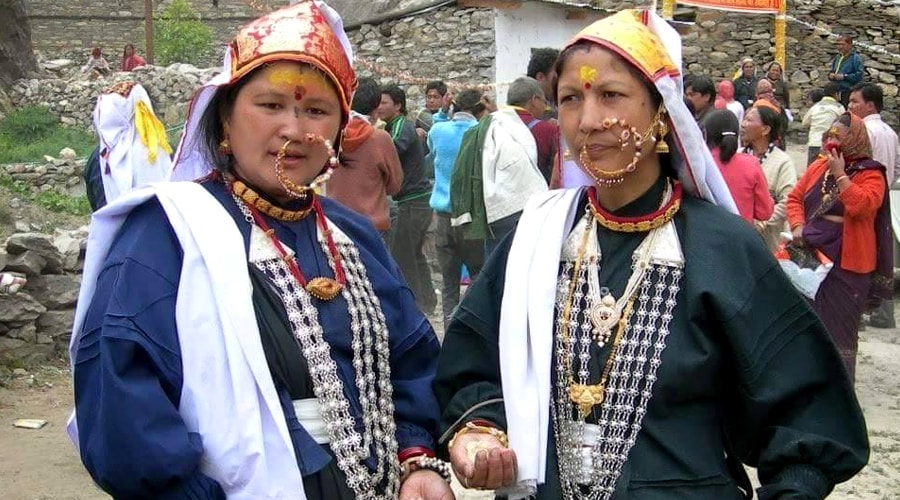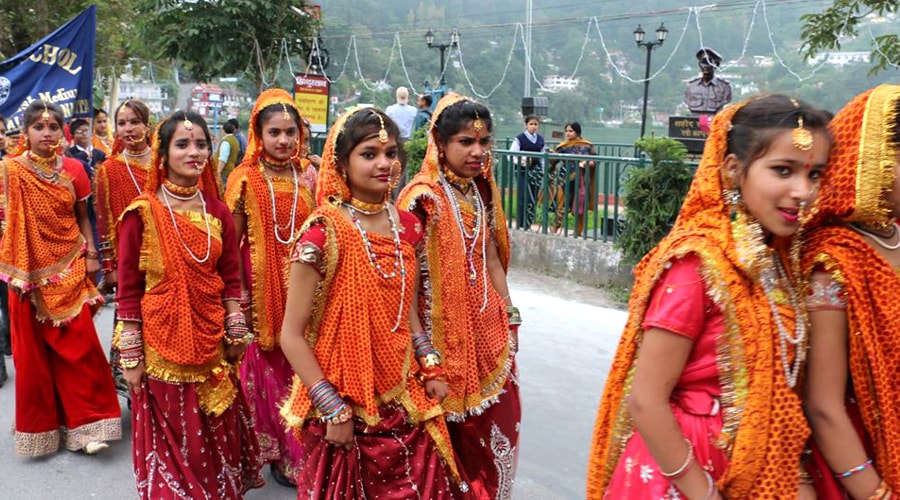Devbhoomi Uttarakhand adorns the northern region of India and is home to some of the most eclectic collection of traditions and culture. The rich heritage here has been well preserved and kept alive with the constant efforts made by the Pahari people of Uttarakhand comprising of Kumaonis and Garhwalis. Being a popular place of residence for people of various ethnicities of the surrounding region many people of different tribes have come together to co-exist in peace here. From their festivals, music and dance forms to puja rituals, way of life and clothing, everything about the people of Uttarakhand are distinct from the rest of India.
For an easier understanding the clothing should be divided according to 2 primary communities inhabiting these parts:
Garhwali Traditional Clothing:
For Men
As a part of their traditional attire the men wear Kurta paired with either Pyjama or Churidar. This is probably one of the most commonly worn clothing in this community which is also often paired up with a traditional Topi or a cap which also serves the purpose of saving the face and eyes from the harsh sun. It also matters of age as young men wear Topi and the senior citizens adorn Pagdis which protects them from the cold season. The influence of commercialisation and British rule is also seen in the transformation in their clothing since some locals can also be seen wearing coats and suits. On the event of the wedding, the men wear a yellow-coloured Kurta and dhoti and the fabric depends on the weather conditions there. This groom’s wedding attire is made out of mainly cotton fabric if it’s the warmer regions and woollen fabric in case of colder regions.
For Women
 The way women tie up their sari here in this region is very different from the rest of India and they are also very particular about the way they wear their sari since they feel like it represents their community and preserves their societal traditions and beliefs. Married women are dressed in silver ornament called Hansuli which adorns the bride’s neck. Guluband is another ornament which kind of looks like a modern-day choker is also worn. It is designed in the bright Colours of the blue band along with golden-coloured squares. Although they wear their traditional clothes to Honour their past and ancestry with the onset of commercialisation they have also started wearing modern clothes which seems like a step forward.
The way women tie up their sari here in this region is very different from the rest of India and they are also very particular about the way they wear their sari since they feel like it represents their community and preserves their societal traditions and beliefs. Married women are dressed in silver ornament called Hansuli which adorns the bride’s neck. Guluband is another ornament which kind of looks like a modern-day choker is also worn. It is designed in the bright Colours of the blue band along with golden-coloured squares. Although they wear their traditional clothes to Honour their past and ancestry with the onset of commercialisation they have also started wearing modern clothes which seems like a step forward.
Kumaoni Traditional Clothing:
For Men
Although very distinct from their often mixed up community of Garhwalis, due to their language and beliefs, the traditional clothing attire of the men belonging to the Kumaoni regions are kind of similar to that of Garhwali people. They also wear Pyjama paired with Kurta due to its location and to ensure comfortable mobility since they have to travel long, rugged distances on foot. For a headgear, they adorn themselves with Topis or turbans are known traditionally as Pagdis. They unlike their counterpart, also wear some sort of jewellery on their necks and hands. This is only specific and limited to the region of Kumaon parts in Uttarakhand.
For Women
 The traditional clothing attire for the women belonging to the Kumaoni community is very different from the women of the Garhwali region. They wear Ghagras paired up with a shirt in the form of a blouse which is also referred to as Kameez in the local languages. This clothing combination kind of resembles the kind of attire traditionally adorned by Rajasthani women. During the wedding events, the women make sure to wear a Pichora which is hand-dyed and coloured yellow. Women who are married make it a point to wear a big Nath or nose ring that covers almost their entire cheek along with silver toe rings and brightly coloured sindoor.
The traditional clothing attire for the women belonging to the Kumaoni community is very different from the women of the Garhwali region. They wear Ghagras paired up with a shirt in the form of a blouse which is also referred to as Kameez in the local languages. This clothing combination kind of resembles the kind of attire traditionally adorned by Rajasthani women. During the wedding events, the women make sure to wear a Pichora which is hand-dyed and coloured yellow. Women who are married make it a point to wear a big Nath or nose ring that covers almost their entire cheek along with silver toe rings and brightly coloured sindoor.
Attire of Tribal Communities in Uttarakhand:
The state of Uttarakhand is widely known for the variety of tribes which makes it a very unique holiday destination as well. Communities like Jaunsari, Bhotia, Raji etc. have stayed here in small numbers ever since centuries. The people belonging to these communities have made sure not to forget their roots and where they have come from. They are also given equal respect by their fellow Paharis and through their clothing, they have also managed to keep alive the spirit of their ancestor. Here is how you can distinguish them based on their local and traditional attire:
Attire of Jaunsari Tribe:
It is a known fact that the people of this community identify themselves to be the direct descendants of the Pandavas in Mahabharat. What makes their style of clothing very different from their mountain brothers and sisters are the colourful jewellery and clothing that seems to stand out from rest. Even the men from the community adorn bold jewellery like big Kadas and necklaces as a sign of their long-kept tradition. Another significant addition is a woollen cap known as Digwa. On the other hand in case of a woman they adorn themselves with Ghagra, a scarf known as Dhantu and a woollen coat to keep them safe from the cold weather. A long coat is worn on special events known as Lohiya or Thalka.
Attire of Bhotia Tribe:
As you make your way higher and deeper into the core of Uttarakhand you will encounter one of the most inhabited tribes of Bhotiya whose ethnicity goes back to the Mongoloids. They reside is very cold and frigid climatic conditions which mean that their clothing is mainly created in a way to combat the cold weather conditions. As raw material they weave their clothes out of woollen yarn and make coats, shirts, skirts, waistcoats etc. the women here also wear large rings, necklaces, nose rings and other distinct jewellery made out of gold or silver. Men choose to wear a trouser along with a long loose gown-like piece of clothing and tie it around their waist with the help of a Patta which is a woollen cloth. They top it off with a cap also.
Suggested Tours



 Call
Call WhatsApp
WhatsApp Enquiry
Enquiry